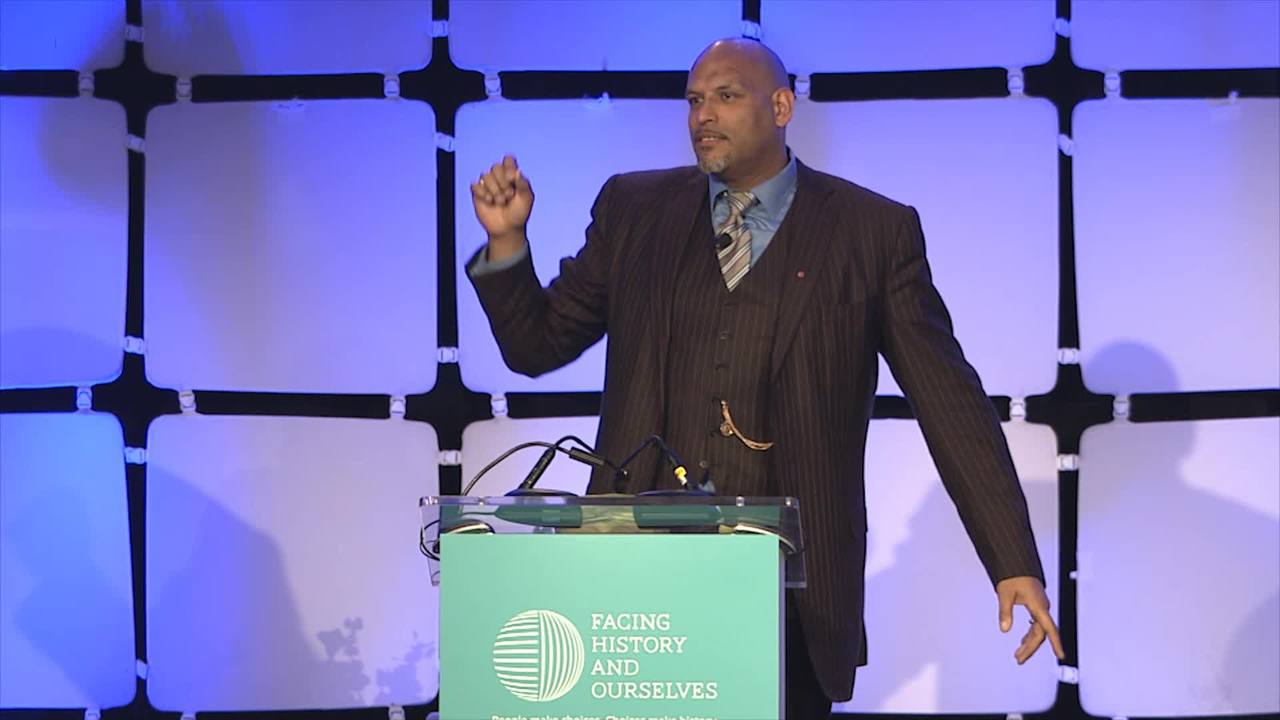Identity is not just self-revelation. It's not just something you come to know about yourself. It's also, in part, made up of how other people see you and how you see yourself in other people. They call this very old-fashioned concept in psychology called the "looking glass self," the "mirror self," the idea that your identity is made up in part by how other people see you.
I remember as a youngster, I arrived at our school at age 11, and I remember thinking I knew what I was all about. I was a fat kid. I enjoyed pie--
[LAUGHTER]
--and cake. I knew this about myself. I also knew that I enjoyed books. I mean, I devoured books-- in the same way I devoured cake, actually.
[LAUGHTER]
I just loved to read. The library was my favorite place. The smell of it alone was like sanctuary. And mostly because the only place you know you're never going to run into other students is in the library.
[LAUGHTER]
And I remember wishing I could be invisible as I walked through the halls, because I was massive and fat and different, and people looked and they pointed and they laughed. And if I walked around the corner too fast and they came towards me, it wasn't laughter, but fear, terror that I would see in their face. And that has an impact on you when you're 11 or 12.
I remember being assigned a book to read. And it was the first time I read a book, and in its pages I saw me. I was assigned this book to read over the course of two weeks. And I got the book in class just before lunchtime, and by the end of lunchtime I was like a third of the way through. Through the various parts of the day, I managed to steal pages and move forward, and on the bus on the way home I finished it.
And I got in and I waited around, because my mother, a single mum, wasn't home when I got home, mostly ever. And I waited around, and I sat on the landing and waited to hear her keys at the door. And I walked up to her with this book and I said, mum, am I a monster?
The book was The Hunchback of Notre Dame, and it was the first time-- if you've read that book, the hunchback, there's a strange reaction to him from the people around. It's not just fear-- it's ridicule and fear, laughter and terror. And that's what I saw everyday, people pointing.
Even as I walk around now, I was upstairs-- and I'm sure it was none of you guys-- earlier on today, and a family walked in to go to the left and I walked out to the left to go to the lunch place. And as I walked past, I knew that if I turned around after about three steps I would see it. And I turned around, and there's a mother grabbing her kids. Not the face of "oh, amazing," no. Just like, "uh." Like a pod had just popped down and an alien had popped out.
A lot of people think we need a safe environment because it's just about this warm and fuzzy experience that young people are supposed to have in education, and it's not really about that. We need a challenging but safe environment, because there is a very narrow strata, a very narrow bandwidth, where young people can be challenged and high achieve, emotionally. And when you're in that sweet spot, amazing things can happen. And when you're outside of it, there's very little chance of high achievement.
And what this does, when people are in environments that don't feel safe, that don't feel supportive, they end up coming to school dressing themselves almost in a body suit, in a "you" suit that is a construction designed to help them blend in and fit, pass. Whatever identity item that we're talking about, it allows them to pass through and at least be invisible, if not outstanding.
The problem is, is that anybody knows who has to dress up in a way that makes them uncomfortable-- and a lot of people do this, a lot of teachers and principals will do this, too-- they have to code switch. They have to come to school with a different set of behaviors. And everybody knows the relief that you feel when you come home at night and it's almost like you unzip that suit and you can breathe again. You can finally take that big breath and relax.
But you also know that you have to be an amazingly high functioning person to be able to manage your day with that kind of suffocating suit on. And kids don't have that capacity, so they come to school wearing this suit that allows them to fit and pass.
And you're asking them to do these really high level thinking and cognitive tasks in learning, and they can't do it because, A, they have no authentic connection. They're disconnected from the world of the school by this suit that protects them, they hope. And they're also suffocated by it. They're just not going to risk unzipping and being seen for the first time as a person in a space where they think there's any chance, any risk, to themselves, or their identity, or their person.
And so it's very true that in the early stages of interventions that it's a really ideal situation people have to create. Teachers have to create this emotional space where it's safe but challenging, where people can be themselves, where people can take chances and fail, where people can tell stories about them and reveal things about themselves without risk of derision, without fear of being marginalized. Without safety, there is nothing-- there is no learning.














